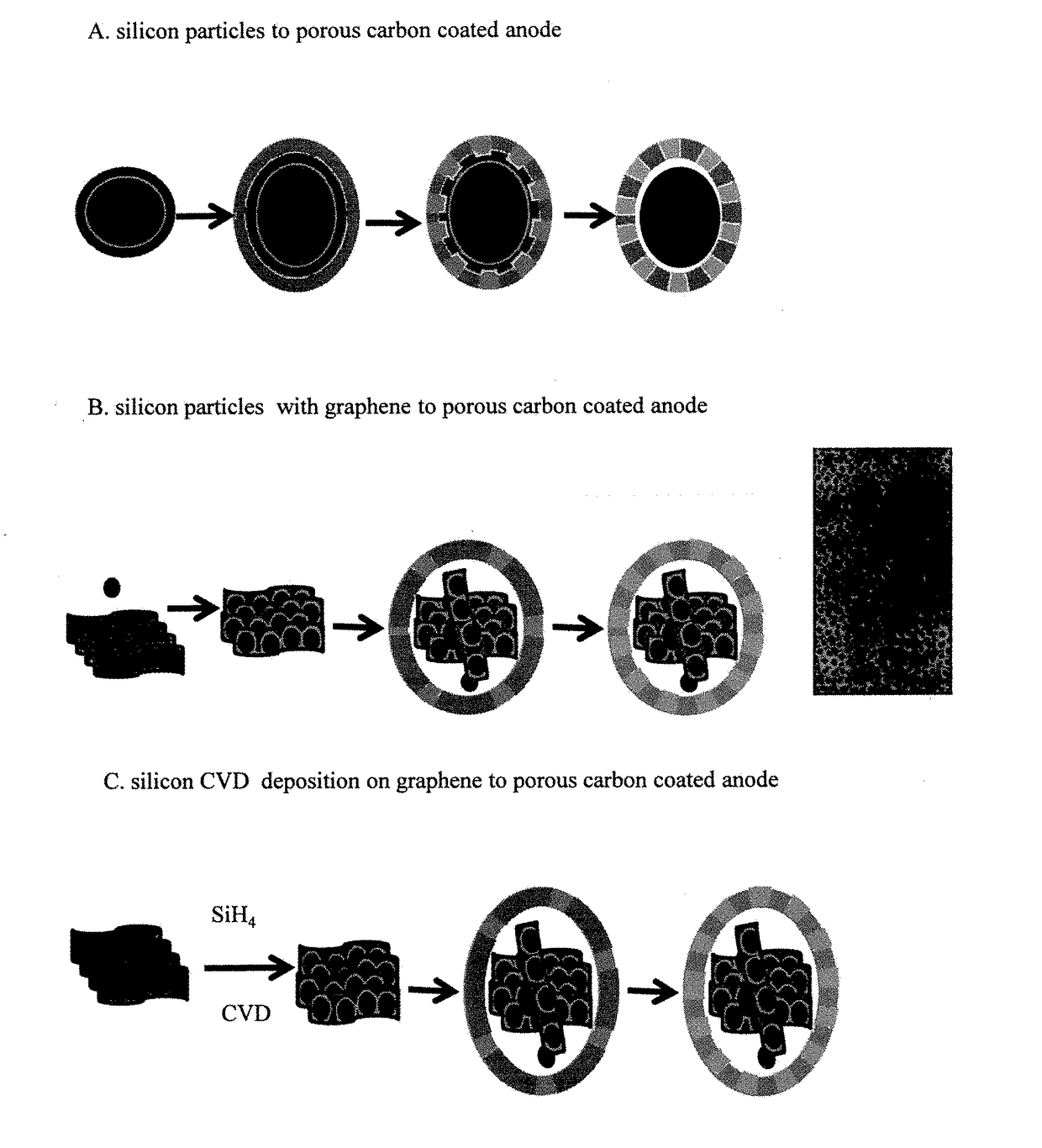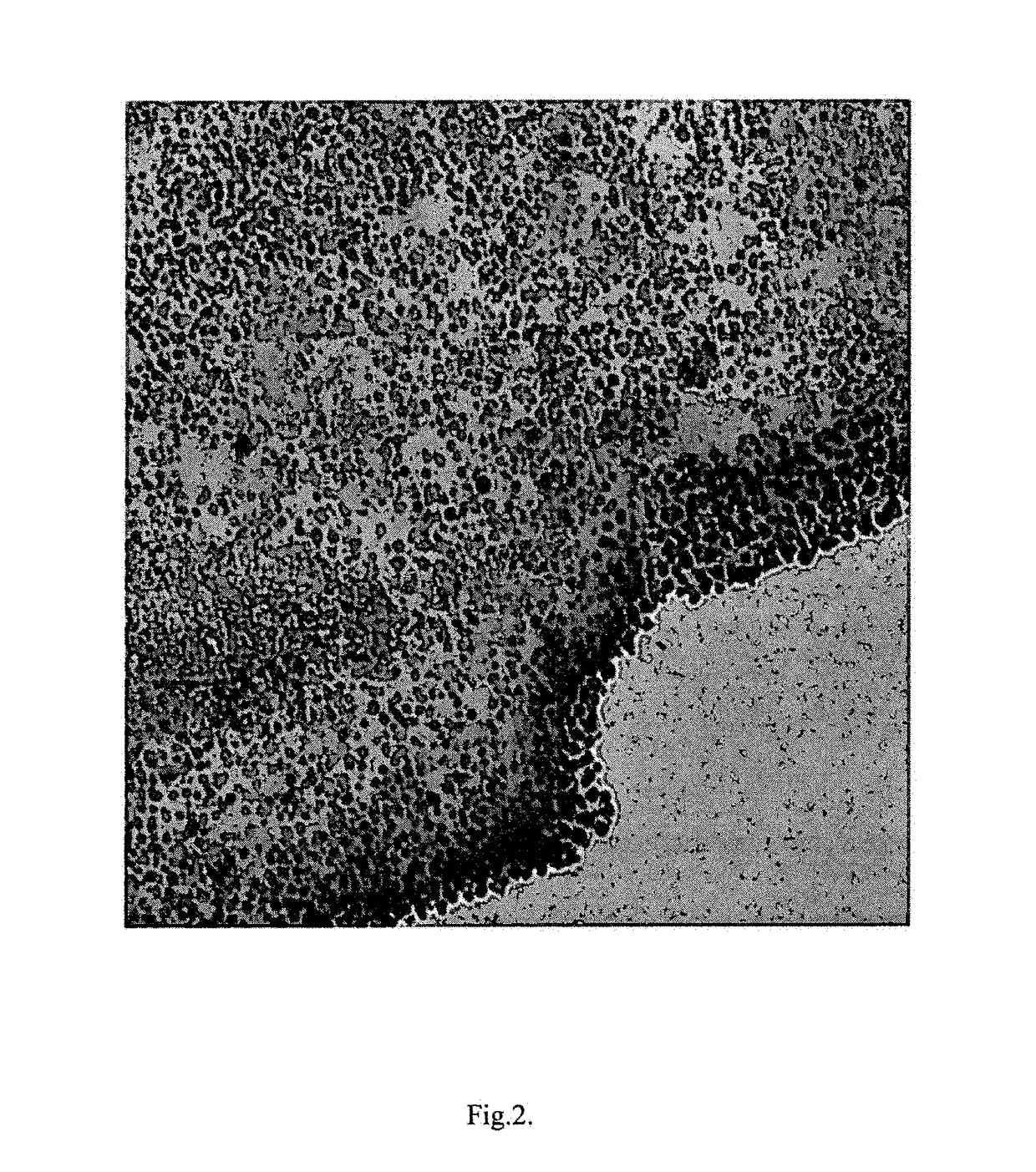Ordered nano-porous carbon coating on silicon or silicon/graphene composites as lithium ion battery anode materials
a lithium ion battery and nano-porous carbon technology, applied in the manufacture process of electrodes, cell components, electrochemical generators, etc., can solve the problem of deteriorating electrochemical behavior of the anode, unable to meet the ever increasing demand for energy density for long-lasting operation of these electronic devices, and relatively low specific capacity of graphite (licsub>6 /sub>, theoretical 372 mah/g,
- Summary
- Abstract
- Description
- Claims
- Application Information
AI Technical Summary
Benefits of technology
Problems solved by technology
Method used
Image
Examples
example 1
CVD Growth of Silicon Nanoparticles on Graphene Oxide
[0033]Deposition of silicon nanoparticles from its gaseous precursor can be achieved via various CVD related methods. The example described is by illustration only. 5.0 grams of graphene oxide was loaded in the middle of a quartz tube inside a tube furnace. The quartz tube was purged with Ar gas for two hours before the pressure was reduced to 5 mbar. The tube was heated up to 550° C. with 5% H2 / Ar mixed gases at flow rate of 25 sccm. When temperature is stabilized, the gas inlet is switched to 5% SH4 / Ar at flow rate of 25 sccm. The reaction was kept for 4 hours before the furnace is cooled down to room temperature with 5%H2 / Ar as protecting gas.
example 2
Silicon Nanoparticles Embedded Inside Graphene Oxide by Mechanical Mixing
[0034]One gram silicon nanoparticles with average size of 10 nanometers and 5.0 grams graphene oxide was dispersed into 50 mL ethanol. The mixture was ultrasonicated for 4 hours before filtered. The black power was collected and dried under vacuum at 80° C. overnight. The collected solid was then transferred into a quartz tube inside a tube furnace and purged with Ar gas for 4 hours. Then the gas was switched to 5%H2 / Ar as the temperature of the furnace was raised to 650° C. and kept for 4 hours before the temperature was lowered to room temperature.
example 3
Synthesis of Ordered Nano-Porous Carbon Coating on Si / Graphene Composite
[0035]2.7 grams phloroglucinol and 3.0 grams F127 were mixed and dissolved in water / ethanol solution (135 mL / 15 mL) under constant stirring at room temperature before 4.0 grams formaldehyde was added to the solution. Then 0.6 gram of conc. hydrochloric acid was added and the solution was stirred until it becomes cloudy. 2.7 grams silicon / graphene powder was slowly added to the cloudy solution. The mixture was stirred overnight. All the solids were assembled into a gel ball and the solution is colorless. The gel ball was washed several times with water / ethanol, alternatively before dried under vacuum at 80° C. overnight. The dried composite was loaded in a quartz tube inside a tube furnace. The tube was first purged with N2 then was heated up to 650° C. with 5% H2 / Ar as protecting gases. The pyrolysis process was kept for 5 hours before the tube is cooled down to room temperature. The black solid was grinded, bal...
PUM
| Property | Measurement | Unit |
|---|---|---|
| diameter | aaaaa | aaaaa |
| temperatures | aaaaa | aaaaa |
| temperatures | aaaaa | aaaaa |
Abstract
Description
Claims
Application Information
 Login to View More
Login to View More - R&D
- Intellectual Property
- Life Sciences
- Materials
- Tech Scout
- Unparalleled Data Quality
- Higher Quality Content
- 60% Fewer Hallucinations
Browse by: Latest US Patents, China's latest patents, Technical Efficacy Thesaurus, Application Domain, Technology Topic, Popular Technical Reports.
© 2025 PatSnap. All rights reserved.Legal|Privacy policy|Modern Slavery Act Transparency Statement|Sitemap|About US| Contact US: help@patsnap.com



